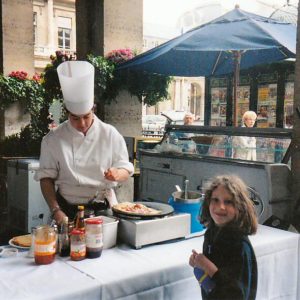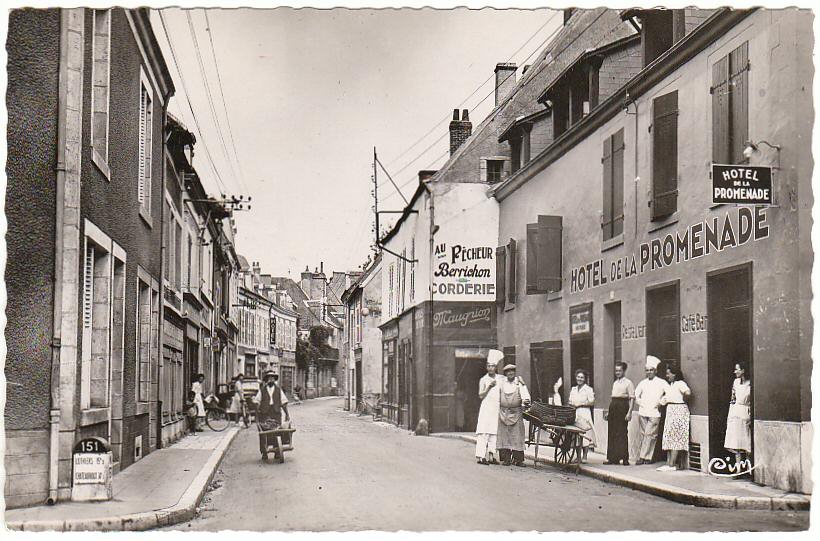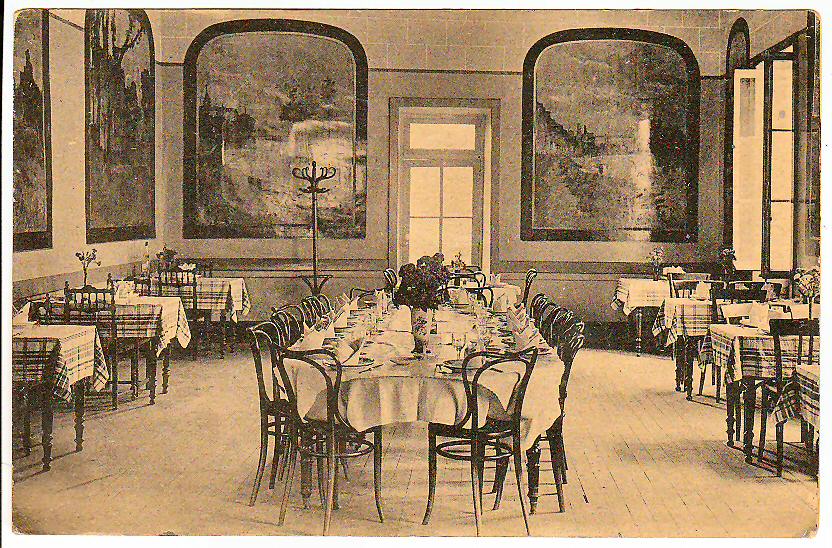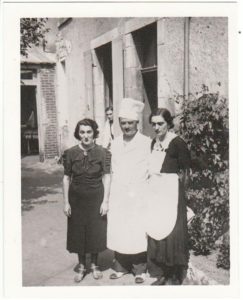THE SCENT OF A CRÊPE

Eating Crêpes in Paris on the Left Bank
Crêpes originated in the northwest region of Brittany, a windswept and rainy section of France located on a large peninsula that extends into the English Channel on the north and the Bay of Biscay on the south. Like the land, the crêpes there were rustic and served like bread, typically made with buckwheat flour (sarrasin), a less expensive alternative to white flour. Over time, savory fillings were added and the name galette crêpe or just galette came to refer, and still does today, to savory crêpes. The more delicate sibling, the dessert crêpe or crêpe sucrée, made with wheat flour, came later.
Today, both savory and dessert crêpes—salées and sucrées—are available throughout France and in the United States and other countries. In some parts of France, the dessert crêpe can be purchased through a window, from a truck, from a semi-permanent stand on a busy street or in a market, and in restaurants. The savory crêpe is almost exclusively found in restaurants and often in those that clearly promote their Breton connection. (Pourquoi pas? To serve les galettes de Bretagne suggests authenticity and history.)

Crêpes in Paris on the Right Bank
In Lourmarin, our favorite restaurant for dessert crêpes—and one of our very favorite restaurants in the Luberon—is La Louche à Beurre. Another time I will wax longingly about meals we have had there; suffice to say here that they specialize in dessert crêpes, including the famous crêpes Suzette. We always save room for crêpes here!
Since there are no crêperies near our home in New Hampshire, I often make my own. Our French teacher, Janine Kolb, taught me how to make these wonderful French pancakes, using her fool-proof recipe.

Madame Janine Kolb
For many years, Janine worked in Montessori schools, where she taught children how to make crêpes (as well as many other French dishes). Using recipes from her childhood in Saint-Gaultier, where she grew up watching her father cook for patrons of their family restaurant and hotel—in which she and her family also lived—and for German soldiers who occupied their home during the war and, later, the American, British, and Canadian soldiers who later freed her village, Janine created a small cookbook for her students. It is a gem of a cookbook, comprised of simple recipes with appeal definitely not limited to children.

Hotel de la Promenade Saint Gaultier, France

The Dining Room in Hotel de La Promenade

Monsieur and Madame Sauvard, Janine’s Parents (Mother on right)
Having tried many recipes for crêpe batter, I can unequivocally report that Janine’s is the best and most fool-proof I have ever made. My daughter claims they are the best crêpes she has ever had! We have made crêpes sucrées for classrooms full of children in our daughter’s elementary school—butter and sugar or Nutella are their favorite fillings—and both sucrées and salées for meals at home for adults and children, alike. They can be served for breakfast, lunch, and dinner. For brunch and an after-school snack (collation, en français). Crêpes are wonderfully versatile. They are always a huge hit!
Janine has given us permission to include her recipe for the crêpe batter here in The Modern Trobadors, where we will offer some of our favorite ideas for sweet fillings and in Cocoa and Lavender, our good friend David’s blog, where you will find one his favorite savory fillings, his rendition of Julia Child’s Crépes au Poulet et Champignons.

To purchase Mme. Kolb’s
cookbook… Click Here.
Only $12.00
The same basic recipe for the batter can be used for either dessert or savory crêpes. With the former, one would add a flavoring like vanilla or almond; with the latter, minced herbs may be added to the batter. With either, the flours may be varied with, for example, buckwheat or whole wheat.
As a bonus to the readers of our blogs, Janine provided a demonstration of the making of the batter and cooking of the crêpes. You will see just how easy—and how fun—making crêpes can be!
Click video below to see her—and the rest of us—in action!
Have a crêpe party with David’s recipe for Crépes au Poulet et Champignons and a dessert crêpe. Heck, go all out and serve crêpes appetizers! (Peut-être, tuck a little brie inside a small savory crêpe—we substituted garbanzo bean flour for some of the white floor in the batter recipe—along with onion confit and chopped walnuts, roll each up, brush them with butter, and slip the tray in the oven until the cheese melt….we took this appetizer to a dinner party for our friend Robin’s birthday and they quickly disappeared!)
For a simple and yet elegant dessert, try sautéing some apples (e.g. Fuji, Braeburn, Granny Smith) in butter and brown sugar and a little Calvados. Thinly slice your apples and coat in fresh lemon juice. Melt the butter in the sauté pan, add the apples, and cook briefly. Then, sprinkle brown sugar to taste on top and cook until just soft (don’t let them get too soft!).
For a crowd-pleasing finish, add a little Calvados (or brandy or rum), and light it! Be sure you are in a safe place when you light it. (I lit a kitchen towel on fire during one of my attempts to flambé les crêpes.)
Place a crêpe (see Janine’s recipe below) on each guest’s plate. In the center of each crepe, put a scoop or two of ice cream (vanilla or dulce de leche are our favorite choices), and then the sautéed apples. Fold the crepe over the ice cream and drizzle on some sauce with a few apples. C’est extraordinaire!
All you need are the ingredients for the crêpe batter (see recipe below), the ingredients for the fillings—will it be dessert or savory or both?—and a crêpe pan! (A good substitute is a non-stick fry pan.) Soon that irresistible scent will be emanating from your kitchen…and you never know who might wander in.
1 2/3 cups all-purpose flour
2 eggs
1 tbsp vegetable oil
1 tsp salt
2 cups whole milk
Oil or butter for coating the pan
Place the flour in a large bowl. Make a well in the flour and drop eggs in the center. Add the oil and salt to the eggs. Beat the eggs, oil, and salt with a whisk or a fork. Continue whisking while adding the milk, a little at a time, into the flour.
Add extract, if preparing dessert crêpes, or herbs if using when preparing savory crêpes. (See Notes on Crêpes below.) Whisk until mixed together.
Let batter stand in refrigerator for at least one hour. The batter should be fairly liquid, like a thick cream; if it thickens too much, add a little milk.
In a small (non-stick, ideally) frying pan—or crêpe pan if you are fortunate enough to have one—put in about a 1/4 tsp oil (or butter) and coat the pan. Heat the pan on medium-high to high (depending on your stove) and, when hot, pour in just enough batter to very lightly cover the surface of the pan. Tilt and turn the pan to swirl the batter around to cover the surface. Lower heat to medium or medium-high.
Let crêpe cook on first side for about 30 seconds, until it is no longer liquid and is lightly browned around the perimeter. Loosen the edges with a table knife or narrow spatula. Then flip the crêpe—by tossing it in the air and holding the pan beneath to catch it—and cook the other side for about 20 seconds. (You can use the spatula to flip it, too.)
Place the crêpe on a plate and keep in a warm oven until ready to prepare or, in the case of a dessert crêpe, put it on a plate, line it with your favorite filling, roll it up, and eat it right away! Crêpes can be stacked and stored in a plastic bag in the refrigerator for three days or kept frozen for one month.
Makes approximately 16 7-inch crêpes or 12 10-inch crêpes.
Notes on Crêpes
If making dessert crêpes you should add extract (vanilla, lemon, almond) or liquor (rum, cognac, Calvados, Cointreau) to the batter. For savory crêpes, the addition of minced herbs (parsley, basil, chives) is a pleasant variation. One other way to vary the batter is to substitute the 2/3 cups all-purpose flour with a slightly smaller amount of buckwheat flour, whole wheat flour, chickpea flour or other type of flour.
Fillings for dessert crêpes include sugar, butter and sugar, jam, jelly, melted chocolate, Nutella, crème de marrons, berries, sautéed apples or pears and ice cream with sauce. Savory fillings typically require more preparation and run the gamut from simple (scrambled eggs) to complicated (spinach, seafood, chicken and mushrooms). Savory crêpes maybe be filled, rolled and then simply sautéed in butter prior to serving. Or, they can be coated with a velouté, Béchamel or Mornay sauce, topped with some extra cheese and then baked till golden brown.

Salut, mes amis! This was great fun co-posting, although I know you did the lion's share of the work! The video – although a lot of work for you – is wonderful – and I especially love the bloopers section. I think I need to come to Madame Kolb for a lesson – my crêpes don't look as good as hers! But they tasted fantastique!
A bientôt, j'espère! David
Hi David,
Many telephone calls, text messages, and emails later…voilà! So much fun….The bloopers highlight some of the fun that day. I hope our readers have as many laughs and that their crepes look as good as yours and Janine's! et oui, à bientôt, j'espère! Susan
Oh la la, Janine que tu es supreme!
La presentation est tres charmante et
je ferai les galettes pour toutes les amies qui sont des gourmandes, mais aussi des gourmets.
Merci pour la recette et j'espere que
je reussirai les preparer a mon anniversaire,
Monique
Hi Monique,
We are so glad that you enjoyed the blog. Janine's crepes are the best! And, she is a natural on film!
Thanks for your comments.
Best,
Susan
hejhej susan and janine — what a treat. the video brings the crepe to life! such a great idea. i may even try them!! global grammy
Hi Global Grammy,
I know you have traveled hither and yon and yet, I predict, these will be some of the best crepes you have had! So pleased to hear that you like the video!
Thanks so much for writing!
Best,
Susan
The Scent of a Crepe! I love it. St. Malo is indeed a special place, as is all of Normandy; Brittany, too. Mount St. Michel in fog at dusk may be unmatched.
Great crepes on the streets of St. Remy de Provence, where Van Gogh still lives in a nearby institution for women. Remind me to tell you about crepes (you must supply the accents) in Avranches.
Later, Lou
Hi Lou,
Perhaps there should be a crepe tour of France!
Thanks so much for sharing your thoughts here and at the cafe!
Best,
Susan
oooh Susan,
One of my favorite memories of France is crepes; I am passing on the recipe to Katie in the hopes she will make some:-) Thank you!
Best,
Peter
ppoole@metrocast.net
Poole Piano Service
RPT, Member Piano Technicians Guild
Providing service to fine instruments full-time for 24 years
Hi Peter,
The next time you tune the piano, I will have some crêpes for you!
Thanks for your note.
Best,
Susan
Your posting reminds me of the rituals of growing up in England. In England and Wales crêpes are called pancakes. Their popularity in Wales perhaps suggests a Celtic connection with Brittany. An American-style pancake, or something very similar to it, is known as a Scotch pancake. Two facts about English pancakes/crêpes should be mentioned – one, they are eaten in the home (they would never have been seen in a restaurant) – and two, they are eaten only on one day during the year, Shrove Tuesday, known as Pancake Day. Traditionally, it was a way of using up rich foods like eggs, butter and sugar before the start of Lent on Ash Wednesday.
When I was a child it was a celebration eagerly anticipated. My mother would do duty at the stove, always in command but severely pressed to keep up with her husband and sons who scoffed down the pancakes as soon as they came out of the pan. I’ve tasted many crêpes in France, but none to compare with those my mother made – but then, I’m outrageously biased.
Her recipe was identical to Jeannine Kolb’s, except that melted butter, if used at all, would have replaced oil. The subsequent treatment though was rather different. To quote from the Penguin Cookery Book, published in 1946 – "When it is cooked … turn out on a piece of (grease-proof) paper sprinkled with sugar, and sprinkle the pancake with lemon juice … and roll up." A generous squeezing of lemon juice is of the essence – without it, I’d say, a pancake is not a pancake.
Up and down the UK, particularly in England, further rituals are enacted on Pancake Day. To quote from Wikipedia – " On Pancake Day, pancake races are held in towns and villages across the country … Participants with frying pans race through the streets tossing pancakes into the air , catching them in the air whilst running. The most famous pancake race, at Olney in Buckinghamshire, has been held since 1445. The contestants, traditionally women, carry a frying pan and race to the finishing line while tossing the pancakes as they go. … Since 1950 the people of Liberal, Kansas, and Olney have held the "International Pancake Day Race" between the two towns along an agreed-upon measured course. After the 2000 race Liberal was leading with 26 wins to Olney’s 24."
Let’s get together on 21st February, 2012, Shrove Tuesday, and we’ll celebrate by making pancakes – sorry, crêpes.
Brian
Susan and Towny, I just re-read your post – and I was thinking that I should order Madame Kolb's book! What other gems are within?
It is early on Saturday morning and I am (hélas!) out of crêpes. Domage. I had the last one before heading off to sleep last night, and filled it with the Chocolatl that you brought me from the market in California. It was so good that I will need to make a batch of crêpes soon to have more!
Thanks again for sharing the recipe and the wonderful video!
David
Ah, other gems in Madame Kolb's book….My favorites include croque Messieurs à la crème, salade de carottes,madeleines, tartelettes aux pommes and tartelettes aux fruits. But, there are other very appealing recipes for simple soups, veggies, and dessert. The book was assembled with children in mind–the recipes are simple and there are photos of children cooking–making it a perfect gift for kids.
But, I assure you that adults will find the recipes just as appealing–I know you know, but other readers may not know, that the French expect their children to eat a much wider range of food than we Americans expect of our children. I recall the menu at Alex's elementary school in Lourmarin, posted outside the entrance every week, was filled with lots of slow-cooked meats with sauces, fish with various sauces, soups of veggies Alex would have never considered edible,and always freshly cooked veggies. Bœuf bourguignon and bouché à la reine were on the menu! Thus, Janine's inclusion of soupe à l'oignon and tomates en paniers are not so surprising!
I have to get more of that chocolate on my next trip to Carlsbad, California!
We are making the savory crêpes from your last post on Cocoa and Lavender tonight!
Susan
10 marketsin Provence are…
1. Lourmarin on Friday.
2. Isle sur la Sourue on Sunday
3. Cucuron on Tuesday
4. Aix en Provence
5. Arles Wednesday and Saturday
6. Gordes on Tuesday
7. Apt on Saturday
8.Roussillon on Thursday
9. Sault on Wednesday
10.Cassis on Wednesday and Friday
I don't know if all of these are the best but it would be fun to go to them.
Monte Dolack
refuge@bigsky.net